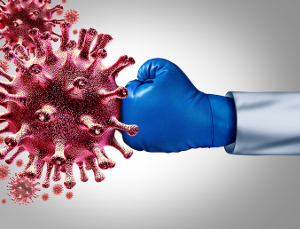Lack of selenium causes virus to mutate
- and become increasingly dangerous
 Around one billion people worldwide are believed to lack selenium, mainly due to nutrient-depleted farmland. Selenium deficiency makes us more vulnerable to infections and increases the risk of a virus mutating and becoming more dangerous. This was shown in previous studies of RNA virus that can cause influenza, hepatitis, HIV, and Keshan disease. Coronavirus that causes the common cold and COVID-19 infections also belongs to the group of RNA virus and has a unique ability to mutate. Three new mutated virus types have been found in mink and stand in the way of a future vaccine. Therefore, we are forced to bolster our immune defense, which is designed to attack virus from different angles. Still, even if we eat a healthy diet it can be challenging to get enough selenium, and that is why an increasing number of international researchers now recommend selenium supplements to help fight coronavirus.
Around one billion people worldwide are believed to lack selenium, mainly due to nutrient-depleted farmland. Selenium deficiency makes us more vulnerable to infections and increases the risk of a virus mutating and becoming more dangerous. This was shown in previous studies of RNA virus that can cause influenza, hepatitis, HIV, and Keshan disease. Coronavirus that causes the common cold and COVID-19 infections also belongs to the group of RNA virus and has a unique ability to mutate. Three new mutated virus types have been found in mink and stand in the way of a future vaccine. Therefore, we are forced to bolster our immune defense, which is designed to attack virus from different angles. Still, even if we eat a healthy diet it can be challenging to get enough selenium, and that is why an increasing number of international researchers now recommend selenium supplements to help fight coronavirus.
Virus particles are microscopic. Even if you lined up millions of them, they would fit within the boundaries of a single dot. Virus has no metabolism. To replicate, it must freeload on other cells. However, the different types of virus are only able to attach to cells with corresponding receptors – like a key that fits in a lock. Once the virus has attached to a suited host cell it injects its genetic material – RNA or DNA – thereby turning its host into a virtual virus factory. That way, countless new virus particles are produced and can continue the process by finding new host cells and attaching to them.
The different type of RNA virus that cause colds, influenza, herpes, and HIV can easily mutate and deceive the immune system, which forces it to reset its “face recognition software” and start all over. You can compare this mutation to replacing a door lock with a new one, which means the old key can no longer be used to unlock the door.
Coronavirus that is found in birds and mammals can also easily mutate. Coronavirus actually belongs to a very large group of viruses, where some are harmless and others can cause colds, SARS (2002), MERS (2012), and COVID-19. Now, a new virus strain has been located in mink and this is probably not the last new type of coronavirus we will be seeing.
Virus does not respond to normal antibiotics and it is very difficult to manufacture effective vaccines against all RNA viruses because they mutate so easily. For that reason, we should focus on bolstering the immune system, which is a highly intricate defense system that nature has designed to attack microorganisms from many different angles.
Life-threatening virus and selenium deficiency
In the northeastern Keshan Province of China where the soil is extremely low in selenium, researchers discovered a fatal heart disease and named it Keshan disease. It was caused by a normally harmless RNA virus named Coxsackie B, which the immune system is unable to fight off if selenium levels in the body are too low. Coxsackievirus may also cause rheumatism and cancer, but back in the 1960s, Chinese scientists found a way to prevent and eradicate the dreaded disease with help from selenium supplements.
Inspired by Keshan disease, the American scientist, Melinda A. Beck, conducted a groundbreaking experiment years later. She inoculated two groups of mice with the Coxsackie B virus. One group was selenium-deficient, while the other group had plenty of selenium. The mice that had enough selenium in their blood were unaffected by the virus, whereas the selenium-deficient mice got myocarditis and died.
Another study revealed that selenium-depleted mice that were infected with influenza virus A showed signs of increased RNA virus mutations. Also, the mice were unable to fight the influenza as effectively as the mice that had plenty of selenium. The influenza-infected mice that lacked selenium developed serious pulmonary complications due to the infection, whereas the mice with plenty of selenium only developed mild symptoms.
According to Melinda Beck’s studies, virus does not mutate into a more virulent form if there is enough selenium and vitamin E in the food. These two nutrients, as it turns out, work closely together, and things become extra critical if there is not enough selenium.
Several studies show that the greater the selenium deficiency, the greater the risk that various RNA virus types mutate and become more dangerous.
In fact, this explains why many new strains of RNA virus, including influenza and coronavirus, originate from selenium-depleted regions of China.
Selenium is overlooked when it comes to immune health, and the widespread problems with selenium deficiency are known to increase the risk of dying of COVID-19 and HIV.
How does selenium prevent RNA virus from mutating?
As mentioned, RNA viruses are able to mutate if they invade another species such as mink, where the virus is forced to adapt. However, in Keshan disease, influenza infections, and other types of RNA virus, mutations may also occur during an infection. These mutations are caused by free radicals and oxidative stress, which is an imbalance between free radicals and antioxidants in the body.
Free radicals are actually produced by the white blood cells and used by the immune defense as missile weapons. But it is very important that free radicals are kept on a tight leash to prevent them from causing oxidative stress, which can damage healthy cells and tissues and cause surviving virus to mutate and pose a greater threat to the body.
Selenium supports the powerful GPX antioxidants (glutathione peroxidase) and TXNRDs (thioredoxin reductases) that protect against unwanted, uncontrollable immune reactions that involve free radicals.
Selenium and its role in the immune defense
|
Why is selenium deficiency so widespread?
You get selenium from organ meat, eggs, dairy products, Brazil nuts, corn and other crops, and fish and shellfish. Even with this multitude of food sources, an estimated one billion people worldwide lack selenium, primarily due to nutrient-depleted farmland. The agricultural soil in Europe, large parts of China, India, South America, southern Africa, and the southwestern regions of the United States is low in selenium. Researchers from the Swiss Federal Institute of Aquatic Science and Technology have conducted a number of climate and soil analyses to predict how the selenium content in soil is expected to decrease even more in the future, influenced by different variables. This is bound to affect the entire food chain.
How much selenium do we need?
Selenium supports around 30 different selenoproteins that are involved in energy turnover, immune defense, metabolism, antioxidant defense mechanisms and a host of other biological functions.
Selenium saturation of one of these selenoproteins, selenoprotein P, is used as a marker to determine the selenium status in blood. But studies show that the current recommendations for daily selenium intake (50-70 micrograms/day) are not enough to guarantee proper saturation of this selenoprotein. According to published studies, it takes at least 100 micrograms of selenium per day to that.
Infections cause a drastic drop in selenium levels in the blood, as the immune system uses large quantities of the nutrient to support various immune activities and the body’s antioxidant defense. That increases the need for extra selenium.
In studies of patients with infectious diseases scientists typically give daily selenium supplementation in the range of 100-200 micrograms. It is best to take selenium yeast that contains a variety of different selenium species because this resembles the natural variety that you get from eating a balanced diet with different selenium sources. The European Food Safety Authority (EFSA) has set the safe upper intake level for selenium at 300 micrograms daily.
IMPORTANT: Also remember vitamin D, vitamin C, and zinc in the fight against virus infectionsIt is no coincidence that viral infections typically occur during the winter period where people lack vitamin D. Besides taking a vitamin D supplement, it is important to get extra vitamin C, zinc, and, and omega-3 that also strengthen the immune system and counteract oxidative stress. According to a recently published white paper by a Swiss panel of doctors and professors from different universities, immediate action is required in terms of healthy eating habits and relevant nutritional supplements that can help the body fight COVID-19 |
References:
Nikki Hancocks. Diet and supplements: Swiss panel publishes COVID-19 recommendations. 2020
www.nutraingredients-usa.com
Olivia M Guillin et al. Selenium Selenoproteins and Viral Infection. Nutrients 2019
Beck M A et al. Benign human enterovirus becomes virulent in selenium-deficient mice. J med. Virol 1994
Arash Moghaddam et al. Selenium Deficiency is Associated with Mortality Risk from COVID-19. Nutrients 16 July 2020
Jones GD et al. Selenium deficiency risk predicted to increase under future climate change. Proceedings of the National Academy of Sciences 2017
Holger Steinbrenner et al. Dietary Selennium in Adjuvant Therapy of Viral and Bacterial Infections. American Society for Nutrition. 2015
Hoffmann Peter R et et al. The influence of selenium on immune responses. Mol Nutr Food Res.2008
